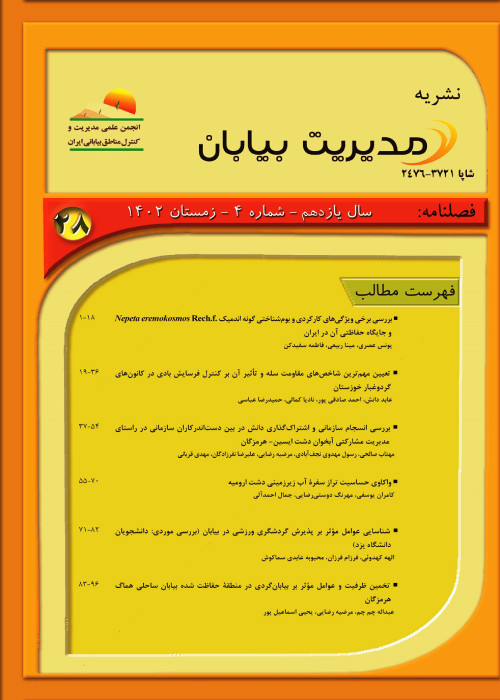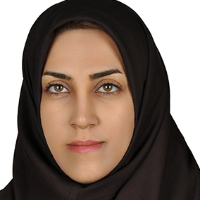Investigating organizational cohesion and knowledge sharing among organizational stakeholders in the direction of cooperative management of the Isin Plain Aquifer in Hormozgan
The integration of inter-sectoral policies is necessary for natural resource management. This is due to the fact that the scope of current environmental and sustainability issues goes beyond traditional sectoral boundaries. The water resources in Iran are facing a problem due to the excessive exploitation of underground water resources. The lack of cooperation and communication among institutions responsible for managing underground water resources is the root of this problem. Numerous studies have examined the use of social network analysis and its effect on natural resource management, addressing the complexity and unpredictability of social-ecological systems. Some researchers have examined the impact of social networks on each other, society, and social processes, while other researchers have explored organizational arrangements for better management. The objective of this study is to identify institutions, categorize them, and analyze the pattern of communication and cooperation between them, to collaborate together in a synergistic manner for collective action in the field of cooperative aquifer management in the Isin Plain.
The social network analysis technique is employed in this study to determine the roles and positions of stakeholders, to establish a management system that is coherent and compatible to balance the Isin Plain Aquifer. The relationship between organizational activists involved in water was analyzed through a social network analysis questionnaire conducted after learning about them in a snowball way and completed by linking cooperative relations and information exchange through a complete network. In terms of water governance and their roles, organizations were classified into different groups. The ecological boundary of the current study of agricultural lands affected by the Isin Plain aquifer and its social boundary are 31 governmental and non-governmental organization related to the Isin Plain groundwater. For this purpose, the results of answering the questionnaires at the organization level were entered into Excel software in the form of a matrix. After adjusting the data,
the data was transformed from the Likert spectrum mode into binary format using the UCINET 6 software, and the desired indicators were calculated. At the macro level, the indices of density, reciprocity, transitivity, degree, and geodesic distance were computed and examined the index of internal and external links at the intermediate level, and the indices of degree centrality, betweenness centrality, and closeness centrality at the micro level of the network. The groundwater governance regime in the study area was investigated using two indicators of density and degree centrality at the macro level. Two indicators of density and internal and external links at the macro level were used to investigate common imaging to achieve water governance.
According to the results, the macro-level indicators in the studied network were not in a positive position, and the organization network of the studied region was found to have a low level of social capital. In addition, 38.71% of organizations related to the participatory governance of water resources were in the central subgroup, while 61.29% of the organizations were in the peripheral subgroup. Due to their role in providing services, government agencies have the greatest impact on water resources in the study area. Furthermore, there are no non-governmental organizations or production cooperatives in this area that play an active role in managing water resources. According to the E - I index, the exchange of information and cooperation in intermediary and protection subgroups is external, and intermediary institutions are willing to exchange information and cooperate with the actors of other subgroups to protect more natural areas. The results show that among the investigated actors, the Regional Water of Company Hormozgan and the police force are among the key political and organizational powers, as a center and source of advice and a communication bridge for other actors. These actors are instrumental in the process of information transfer and cooperation in the organizational network of the studied region. Thus, these two actors are considered flexible bodies that can be effective in the successful implementation of cooperative management of water resources to balance the aquifer of the Isin Plain with less time and cost. The social network analysis revealed that the actors have weak interactions for managing aquifers in the Isin Plain, and their influence and powers in the network are also different. The weak cooperation of different groups involved in the management of groundwater resources of the Isin Plain can reduce collaborative activities effectiveness, lead to conflicts in their actions, and prohibit the sustainable balancing of the aquifer. Non-governmental organizations and production cooperatives either do not exist or are not actively involved in aquifer management. In the implementation of participatory management programs, it is possible to utilize the capacity of influential and key actors to promote the integration of stakeholders and water policies. It increases their participation in relevant restoration and balancing projects, and improves the management of water resources. The governance system for managing groundwater resources is centralized and uncoordinated, depending on the network's centrality, which indicates low power distribution, coordination, and adaptive capacity. Furthermore, there is a lack of coherence in the structure of knowledge shared among stakeholders. The Isin Plain's water resources management depiction does not focus on negotiation, but rather on ambiguity. Therefore, it is necessary to achieve cooperative management of the aquifer in the studied area, increasing cooperation and two-way communication between organizations and more communication with less key actors, especially non-governmental organizations
- حق عضویت دریافتی صرف حمایت از نشریات عضو و نگهداری، تکمیل و توسعه مگیران میشود.
- پرداخت حق اشتراک و دانلود مقالات اجازه بازنشر آن در سایر رسانههای چاپی و دیجیتال را به کاربر نمیدهد.




